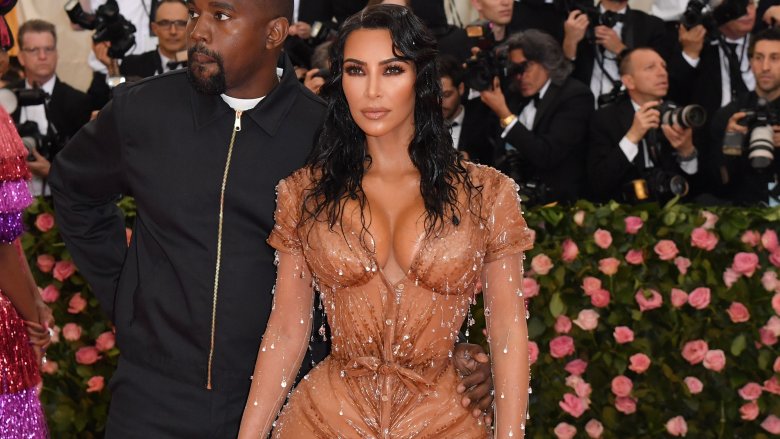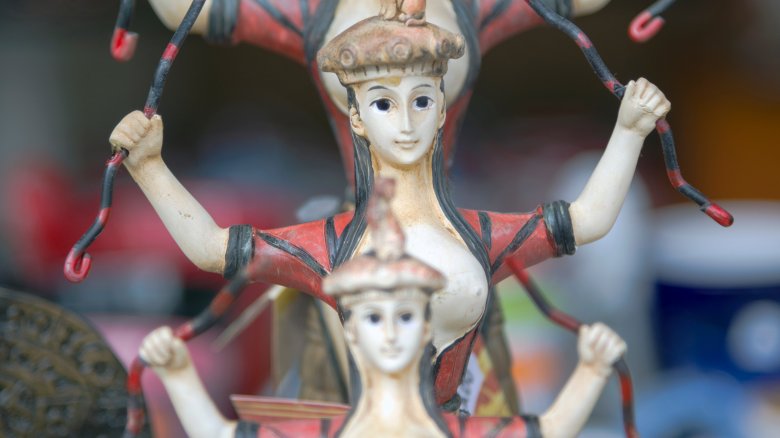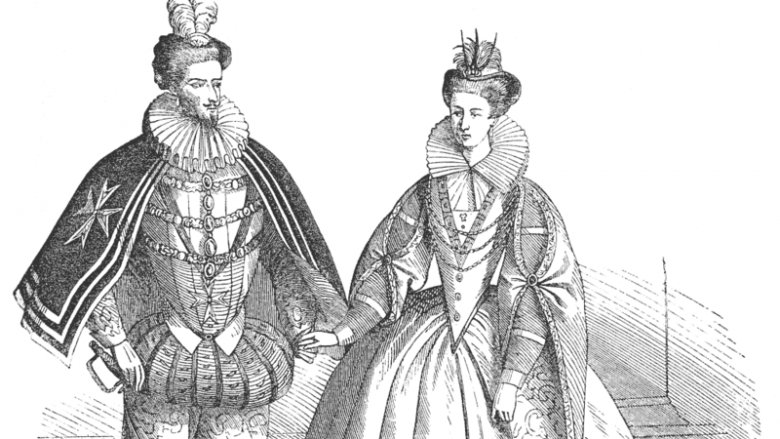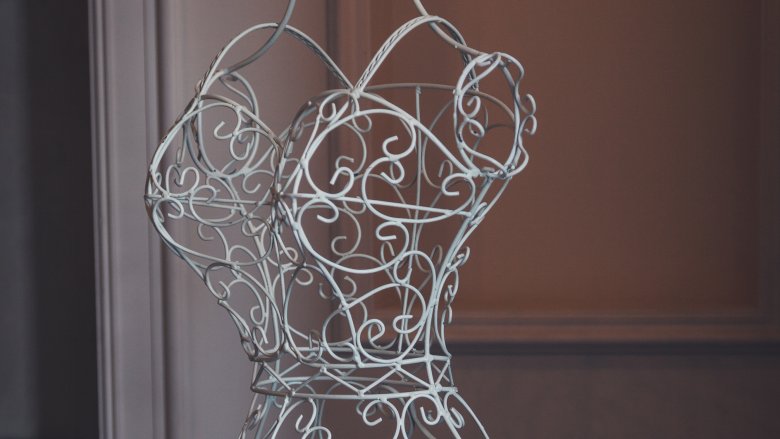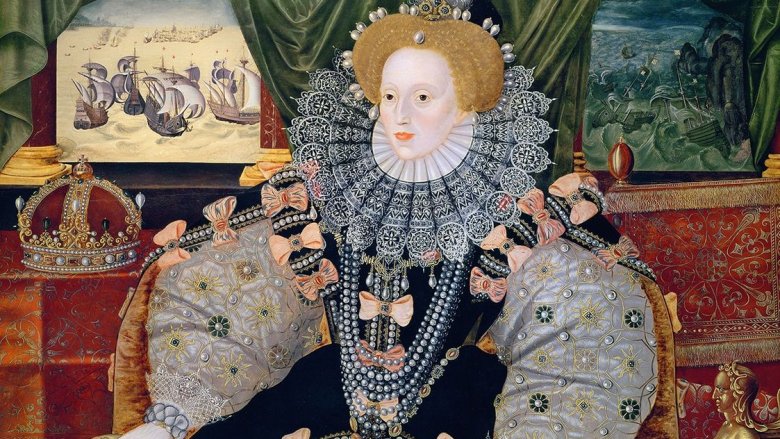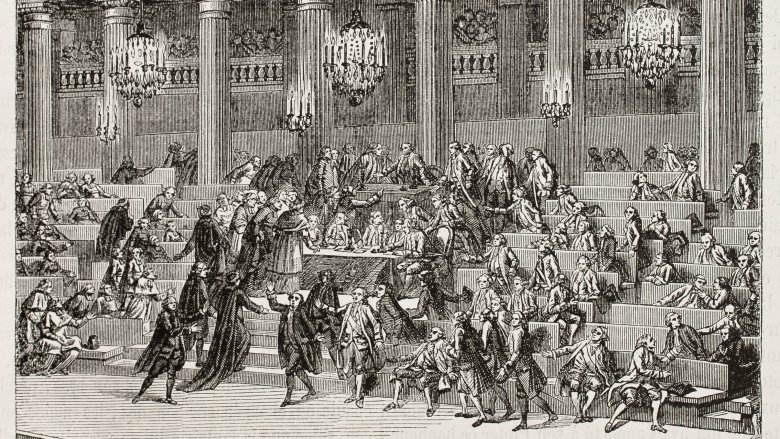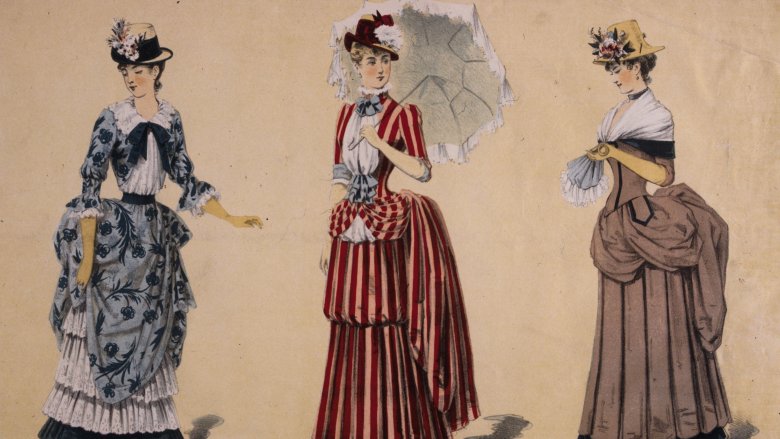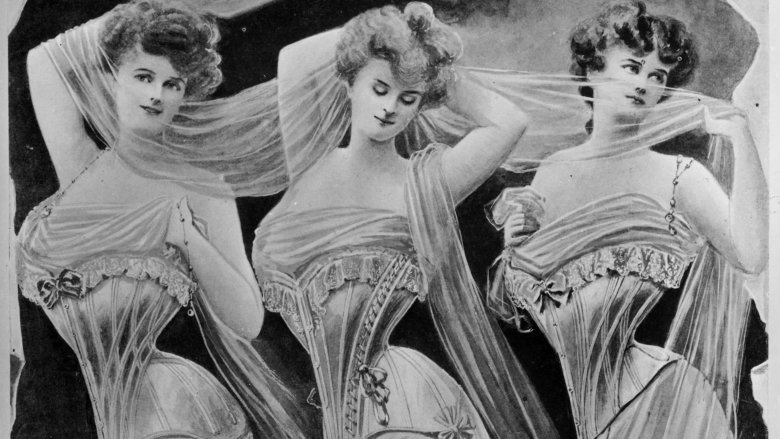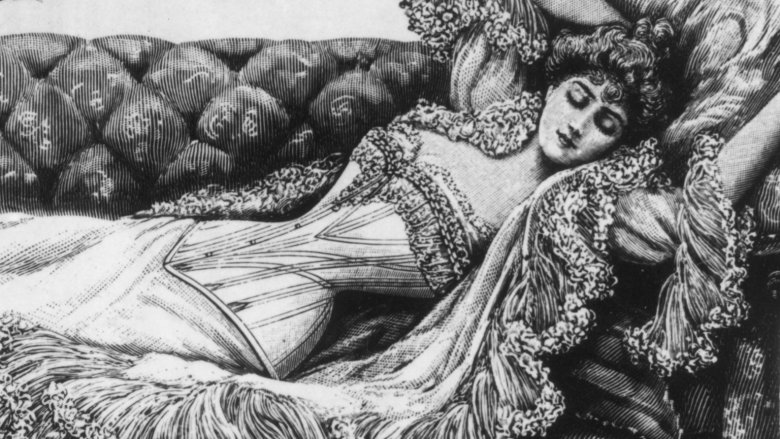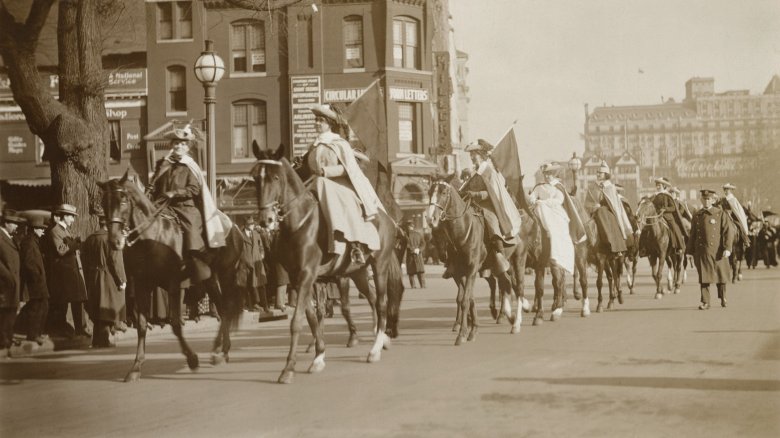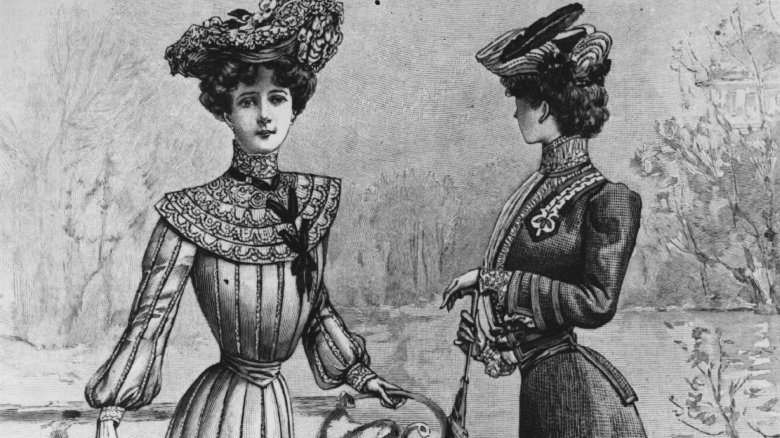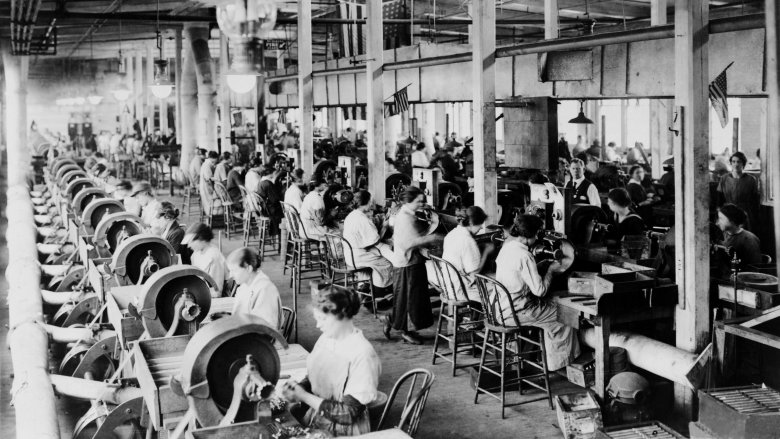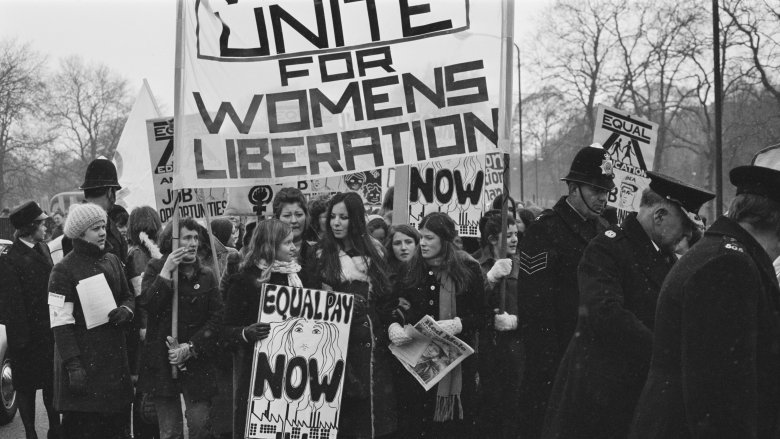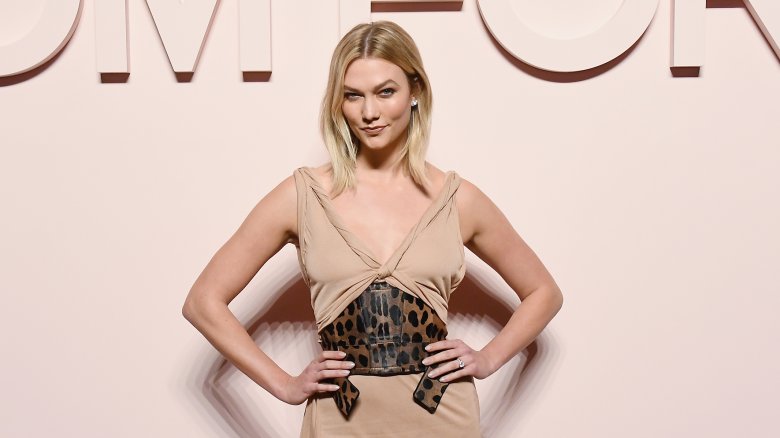The Complicated History Of Corsets
Kim Kardashian donned a corset as she walked the 2019 Met Gala red carpet, highlighting her famous curves and once again shocking the public. In a behind-the-scenes video with Vogue, the reality TV star revealed just how strenuous wearing the tightly laced corset was. "Okay, so Anna, if I don't sit down for dinner, now you know why. I'll be walking around mingling, talking, but I cannot hardly sit," she stated, addressing the magazine's editor-in-chief Anna Wintour in the video.
Kardashian isn't the first to bring the pinched look back. The corset has seen quite the revival over the years, but not many people know the truth about its past. Most people are probably familiar with the image of a woman being laced so tightly that someone could easily grab her around the waist with two hands. The corset is assumed to be a tool of oppression that is staunchly in contrast with the idea of feminism, but the only way to find out if that is the case is to research and look at the evidence. Here is the complicated history of the corset.
Ancient origins
The first instance of what we might consider a corset actually appeared in Crete. The Snake Goddess sculpture that was found in a palace in Knossos dates back to circa 1600 B.C.E. Above the goddess' aprons is a tight band of cloth that appears to hold up her bare breasts. This particular garment was called an apodesmos. It wrapped around the front part of a woman's body and was fastened in the back by pins.
Of course, it was not called a "corset" since the term corset is Latin in origin and the city of Rome was a good thousand years off. However, the make and utility of the apodesmos is incredibly similar to that of a corset. Rome itself would have women using a strophium to bind breasts and shape a woman's body to the slender ideal. Centuries of development in undergarments would eventually bring us to the more familiar corset of the 16th century.
Stays and corsets
Part of the difficulty of tracking the corset's history is that clothing terms can change rapidly. Elizabeth Ewing did her best to put together a good timeline in her book Fashion in Underwear: From Babylon to Bikini Briefs. The first use of the word corset came in medieval times with the French word "cotte" to describe a cloak for men. It wasn't until later, around the 1400s, that the corset would describe a "figure-defining and rigid" garment that was worn above a linen shift. It wasn't even an undergarment yet.
From the 17th century onward, the term "stays" was used interchangeably with corset, further confusing the issue. In any case, these pieces were stiff, but they were still simply just cloth and paste. The piece was a close-fitting bodice that accentuated a narrow waist, sort of like Spanx. We'd have to wait some time longer before stronger material was used.
The mythical metal corset
You may have seen the horrifying image of a metal corset at some point, a perfect visual metaphor for the societal restrictions women have faced. But, well, it's a complete fabrication. There were iron devices from the late 1500s that resemble corsets, but, as fashion historian Valeria Steele explains in her book The Corset: A Cultural History, they were used for posture and orthopedics. The devices were used to "correct spinal deformities," such as scoliosis, and they were even padded so as to not hurt the wearer. Steele also noted that there's been no proof that these metals corsets were donned as stays.
So why has this myth persisted? Steele explains that the metal corset has suffered many accounts of modern forgery, much like the medieval chastity belt. She further pointed out that fetishists throughout the 20th century used metal corsets for private purposes and many of the forgeries seem to take these as inspiration.
Whalebone and the rise of the cultural body
Catherine de' Medici was queen of France for some time in the mid-1500s. When she wasn't leveraging three civil wars, de' Medici was greatly influencing France's culture. Elizabeth Ewing explains in her book Fashion in Underwear: From Babylon to Bikini Briefs that de' Medici despised a thick waist and considered it the "height of bad manners." She brought over a much more rigid corset from her homeland of Italy and made the more conical, "drainpipe shape" fashionable for women. This would continue to thrive during Queen Elizabeth I's reign, with the addition of her iconic ruff. Just decades later, whalebone would become the chief component in corsets to achieve this shape, due to its elasticity and flexibility, in order to support this fashion trend.
This is perhaps when what Dr. Denis Bruna calls the "cultural body" began to manifest. Bruna curated the "Fashioning the Body" exhibit at the Bard museum in 2015, which highlighted how underwear — particularly corsets — were used to shape bodies throughout history. "It's very important because you can see that the natural body doesn't exist," Bruna told the Observer. "We have a cultural body [each time the fashion changes] and each time, the body tries to catch the fashion of the time."
The French Revolution
The Enlightenment period was a huge historical shift in philosophy, art, science, and modern attitudes. It's primarily characterized by the ideals of religious tolerance, skepticism about blind faith, and liberty. It should come as no surprise then that these very ideals were the bedrock of the French Revolution. In the same country where Catherine de' Medici had practically made the corset necessary in court, women were casting off their corsets in protest.
This was exemplified in 1793 by the Société Popular et Républicane des Arts, a replacement for the Royal Academy of Arts. The Société proclaimed that clothing should be practical and should not exemplify status or restrict movement. The corset did exactly both of those things and was thus considered a faux pas. This trend would not last long after the end of the revolution, but it's interesting that the notion of the corset as an instrument of oppression started around this period. It's an idea that would be repeated over and over again.
The Victorian hourglass
Corsets up until the Victorian age focused heavily on the waist, but we all know what corsets eventually drew attention to: the chest. During Napoleon's reign, the waistline began to rise to just up under the breasts, creating the now-familiar Empire waistline. From here on out, the, ahem, girls were set front and center. Corsets in this brief period were shorter and more closely resembled modern bras than previous corsets. Eventually, the waistlines dropped back down again, but the focus on breasts remained. Thus, the hourglass figure arrived in corsetry.
The hourglass shape became the controversial sticking point of corsets. Ewing points out in Fashion in Underwear that this is where the "tight-lacing" trend began, which put the body under immense pressure to the point of it becoming a health concern. Countless doctors at the time warned of the dangers of tight-lacing and encouraged women to give it up. Interestingly enough, some women were outraged at this. Ewing quotes one such angry letter from a woman boasting a 16-inch waist, "If the various organs are prevented from taking a certain form or direction, they will accommodate themselves to any other with perfect ease." The jury's out on this woman's medical authority.
Catering to the male gaze?
Already we've seen the corset as a symbol of oppression, and even today it is assumed to be a patriarchal tool. However, based on the evidence, men apparently hated corsets. Valeria Steele, the director of the Museum at the Fashion Institute of Technology, explained in an interview with Collector's Weekly that men regularly protested against corsets and believed them to cause "hysteria," which is typically the misogynistic catch-all of "women be crazy." Steele explained, "Women wore the corset because it made them feel attractive and properly dressed." The phenomena is interestingly similar to the current controversy of makeup.
Nevertheless, Steele was quick to point out that women wore corsets to obtain the ideal shape, i.e. youthful and sexually desirable. Men did not force women to wear corsets, but the inclination to wear one was shaped by the desires of men. Steele illustrated this instance of history repeating itself, saying, "It [corset] acts like a proto-Wonderbra and also emphasizes the waist-hip differential, which makes you look younger, slimmer, and curvier—which is still what everybody wants. But now women get on a StairMaster or get plastic surgery instead of putting on a corset." It's difficult to say where a woman's wants end and a patriarchal demand begins.
Not as dangerous as you think
It's critical to note that the health concerns regarding corsets were associated with "tight-lacing." The Museum at the Fashion Institute of Technology director Valeria Steele claimed that most women only reduced their waist by one or two inches. "A lot of people believe in the 16-inch waist being typical when, of course, most corsets were no smaller than in the 20s," Steele told Collector's Weekly. No one died from wearing a corset, nor did they have to have their ribs removed, as one myth claims.
"Most modern people are wildly naive in believing the most absurd antiquated medical accusations about corsetry," read the Collector's Weekly article, in regards to the claim that a corset could misshape the liver. According to Steele's research, corsets were blamed for causing hysteria and cancer. Still, that's not to say the corset was healthy. It did move organs around and could cause constipation and indigestion. Plus, it caused obvious issues for any pregnant woman trying to wear one. Still, like the metal corset, the modern notion of the corset's danger to a woman's health has been wildly exaggerated.
Underwear reform
The women's suffrage movement began in the 1800s for both the United States and Britain. Women were reevaluating their place in society and within this large movement began the Victorian dress reform. The dress reform movement focused on practicality and comfort in women's clothing. Naturally, the corset was a hot-button topic. American feminist author Elizabeth Stuart Phelps Ward urged women to, "Burn up the corsets! ... Make a bonfire of the cruel steels that have lorded it over your thorax and abdomens for so many years and heave a sigh of relief, for your emancipation I assure you, from this moment has begun."
The need for less restrictive clothing was heightened as more women became physically active and took up hobbies like hiking and bicycling. Women were even starting to have the gall to wear trousers! The race to create sensible underwear was on. Underwear reformists — yes, that's what they were called — endorsed the amazingly named Emancipation Suit, which featured a knit shirt and drawers that were connected. Was the age of the corset over?
The sensible Edwardian corset
A few corsetiers attempted to keep up with the need for a more mobility-friendly corset. For instance, Dr. Inès Gaches-Sarraute shared her new corset design. But while her intentions may have been good, the S-shaped curve the corset forced women into may have actually been worse for them. Steele explained to Collector's Weekly that this corset's awkward shape put a lot of strain on the spine. Still, it was popular for a time.
Designers like Paul Poiret looked to remove the need for corsets altogether by creating clothing that accentuated natural curves, and the corset continued to evolve into the 1900s. Steele said, "You're getting a shift away from what high Victorian and Edwardian fashion writers described as 'the Venus ideal' and a movement towards 'the Diana ideal,' which was slimmer and more athletic." The corset had undergone a major reform and still survived. But something was coming that would remove the corset as a staple of women's undergarments.
Bras for battleships
In 1917, the U.S. War Industries Board asked women to stop buying corsets, as noted by NPR. This was due to the fact that most corset frames were made with metal, and there was a metal shortage for ammunition and military supplies. Supposedly, the ban resulted in 28,000 pounds of extra steel, enough to build two battleships. This ban was exceptionally fortuitous for Caresse Crosby, who had patented the first U.S. bra in 1914. Crosby, who was born Mary Phelps Jacobs, noted in her patent that the bra "does not confine the person anywhere except where it is needed."
As more women needed to work in factories in the coming war efforts, the lack of confinement the bra brought was indispensable. The 1920s saw the rise of bandeau bras for the flat-chested flapper and the later addition of an elastic band in the 1930s further cemented the bra's place on women's chests (via NPR). Corsets would still be manufactured, but they were not nearly as popular as they had once been. The public had simply moved on.
The women's liberation movement
The women's liberation movement (WLM) began in the 1960s and would move through to the 1980s. This was long after the corset was being used by the average woman in her everyday life. Perhaps one of the most iconic moments of the WLM is the "bra-burning feminist." This refers to the Miss America protests of 1968, as noted by the BBC. Women tossed various items symbolizing female oppression — including lipstick, mops, curlers, and yes, corsets — into the "Freedom Trash Can." Interestingly enough, no burning actually took place. According to People's World, a reporter compared the protests to the draft-burning Vietnam War protests, thus conjuring that image.
Robin Morgan, one of the protest's organizers, told the BBC that, if the protests were held today, she would throw in "really high-heeled shoes and control underwear — which basically are corsets." Despite being out of regular use for decades, the corset has remained a symbol of oppression from the WLM to today. Whether that portrayal is fair is up for debate.
Modern revival
Despite the ups and downs the corset has faced, it's back in fashion. Stars like Kylie Jenner, Bella Hadid, and Hailey Baldwin have taken to the trend and have been seen strutting around in their laced-up corsets. While many are happy to hop on the corset train, there is still concern over whether this is a step backwards for women. Not everyone feels that way, though.
Nikkii Adams, a psychologist, is a modern corset-wearer, and she is not afraid to admit it. "I love my corset," she told NPR. "And I was led to my corset; it was like divine intervention." She added, "I want to walk into a room and have everybody say, 'Oh, my gosh, what is she doing?'" Adams wears her corset to feel good about herself and to fit a shape she wants. However, is that shape not influenced by a patriarchal standard of beauty? No one can really say.
What the future holds
Fashion historian Valeria Steele has said, "The meaning of any item of clothing is not embedded in the clothing itself; it's something we create and are constantly renegotiating," as reported by The Guardian. That's exactly what's happening with the corset. Despite the feminism concerns, people are looking to reclaim the corset for womankind. According to The Guardian, the fashion world is fascinated with the corset, but is looking to change it up. Corset belts and shirts with lacing are more the name of the game now.
The corset has been a simple supportive undergarment, an empowering body-modifier, and a horrible tool of the patriarchy, all depending on what era you're examining the item in. Hopefully, it'll be used for good in the days ahead. Steele seemed hopeful as she concluded, "The point is that it's not something that others are deciding for us any more. You don't have the pressure of society, or your mum, or grandma saying you've got to wear a corset or people will be shocked. It's like, I'm doing this myself — say it's a mistake if you want, but it's my choice."
